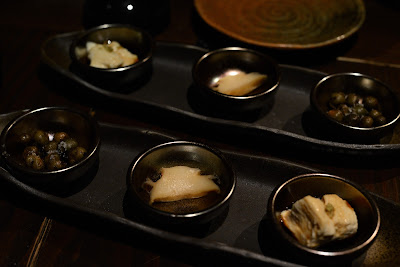Mr. Ishida Masaichi says: "is that only bamboo crafts can be started from raw materials. It is very interesting to make it from scratch. It is not very easy to do it yourself. It is uncomfortable to make things for others. It is also uncomfortable. The sale of a hammer, the tool is also very simple. It can be made into such a shape, not because of the characteristics of bamboo, but by the craft, all rely on oneself."
Mr. Ishida shows us what is Kyoto's "Artisan Spirit"
 |
| Bamboo art works |
We really loved these beautiful bamboo art works and after we left we next decided to try famous Kyoto pickles at Daitokuji Pickles Shop "Daikouhonten". Pickles developed in Kyoto, are typical Kyoto vegetables,because this region was excellent not only for growing the vegetable, but also because the people of this area developed superb preservation technology for pickles. The local people say that pickles are so popular because their culture is to produce these delicious vegetables just follows the blossoming season in Kyoto.
Kyoto
pickles are pickled to perfection by thoroughly pickling one by one. This process takes a long time but it brings out the
original taste of the ingredients of the seasonal vegetables.
Inside the shop, we patiently waited for each customer to prepare a cup of tea and to select their favorite pickles from the many various kinds of seasonal pickles. Below you can see some of the many types of chopped and flavored pickles that we selected. WOW! What great selection to choose from and lots to take home to enjoy!
To learn more, please visit Daikouhonten's website:
https://www.daikouhonten.com/shop/
https://www.daikouhonten.com/shop/
After we enjoyed these delicious Kyoto pickles they increased our appetite for more, so we rushed to the famous "Kyoto’s Kitchen- Nishiki Market ". This area offers an extensive range of food stalls and stores that
strive to cater to your materialistic and hunger desires. We found almost all typical Kyoto food-related delicacies including Kyoto vegetables, Tukemono, Tofu, Yuba, fresh seafood, eel, and so much more. This market area also sells everything from
scrumptious street foods to finely crafted tableware with unrivaled quality,
comprising kitchenware, ornate souvenirs and more with the elegance that is truly Japan.
Nishiki Market has so many little treasures tucked in this wonderful market that you really
can’t go wrong stopping at any shop. Once you start shopping, it is difficult to stop because there is so much to choose from. This is one place that you truly must visit when you travel to Kyoto!!
We have never visited such a beautiful and exciting market anywhere else in the world and we are already looking forward to visit again when we next travel to Kyoto.
For more info visit the Nishiki Market's website: http://www.kyoto-nishiki.or.jp/about.html
After leaving the Nishiki Market, we headed to the Kyoto train station for the next part of our Japan vacation. We were tempted for one final sweet touch of Japanese green tea with ice cream delicious treats at the Kyoto Train Station to finish our wonderful Kyoto trip.
What a fabulous time we had in beautiful Kyoto. We learned so much about Kyoto's historical past visiting the shrines and temples. We saw so much about the sights and sounds of modern day Kyoto. And of course we enjoyed the wonderful crafts, art and food that Kyoto has to offer. You really should plan on visiting Kyoto sometime soon.




































































































































